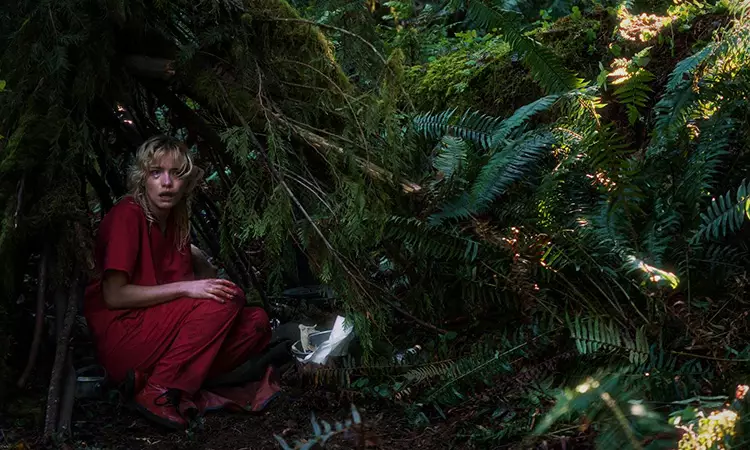In the thrilling realm of horror cinema, few films dare to delve into the unsettling psychology of love and violence as precisely as “Strange Darling.” Directed by JT Mollner and featuring at the 2023 FrightFest horror festival, the film unfolds over the course of a single day, painting a chilling portrait of a serial killer’s deranged pursuit. The narrative is intricately composed of six non-linear chapters, which elicit an urgent tension that mirrors the unpredictability of obsession in relationships. Anchored by the portrayals of Kyle Gallner as The Demon and Willa Fitzgerald as The Lady, the film deftly captures a scenario that is both horrifying and hauntingly human.
The premise revolves around The Demon, a predatory figure who relentlessly hunts an already injured woman amidst the unforgiving Oregon wilderness. Fitzgerald’s character, The Lady, showcases a desperate struggle for survival as she attempts to outsmart her tormentor. Yet, with each passing moment, she becomes increasingly vulnerable, creating a palpable sense of dread that grips viewers from the outset. This riveting battle of wits and wills not only poses the question of survival but also reveals the emotional complexities underlying human interactions, even in their most twisted form.
Vision and Ambition Behind the Camera
Mollner’s artistic vision for “Strange Darling” stems from a profound desire to evoke strong emotional responses through a stylized atmosphere. In conversations with cinematographer Giovanni Ribisi, it becomes clear that the movie’s conception was driven by a vivid, almost surreal image of a woman in distress navigating a dark, treacherous landscape. Ribisi recounts how the film’s initial vision blossomed from a “fever dream,” one focused on reimagining the archetypal ‘final girl’ trope within horror.
Mollner’s ambition to make viewers “feel like [they’ve] been dipped in mood” is ambitious. He aimed to evoke not only fear but also lingering introspection, leading audiences to reflect on their own emotions long after viewing. His references to influential films, such as Ingmar Bergman’s “Cries and Whispers” and David Cronenberg’s “Dead Ringers,” highlight an aspiration to straddle the line between beauty and horror—crafting a tale that resonates with a deep psychological weight.
The collaborative relationship between Mollner and Ribisi emerges as a vital aspect of the film’s development. The pair first crossed paths through a common acquaintance at Kodak, which ultimately served as the backbone for their professional connection. Over several years, they shared scripts and ideas, fostering a rapport that resulted in Ribisi’s fervent call to be a part of the project.
This bond, contrasted with the often impersonal dynamics of film production, fortifies “Strange Darling.” Ribisi’s involvement extends beyond his usual acting roles, as he plays an instrumental part in shaping the film’s visual storytelling. Their commitment to authenticity enhances the narrative’s integrity, allowing them to explore bold themes surrounding the darker aspects of love and violence without succumbing to commercial pressures.
The film’s narrative is marked by its refusal to appease all viewers—a significant point of pride for both Mollner and Ribisi. Acknowledging that “Strange Darling” grapples with challenging subject matter, Mollner emphasizes the importance of portraying complex characters who elicit empathy. Despite the gruesome actions of the protagonist, the filmmakers aspire for the audience to inhabit the psychological landscape of both lead characters, creating a tension between sympathy and horror.
By presenting a simple narrative anchored in profound emotional conflict, “Strange Darling” seeks to challenge viewers’ perceptions of morality and human connection. Mollner’s hope that the intricacies of character development would reverberate with audiences speaks to a desire for meaningful engagement rather than straightforward consumption. In the end, this approach invites viewers to traverse the uncomfortable terrain where love morphs into something sinister—disturbing yet undeniably compelling.
“Strange Darling” represents a daring exploration of human psyche, love, and violence—an experience that lingers well beyond its runtime. As the film navigates the complexities of its characters and the psychological strains of their relationship within a horror framework, it fosters a dialogue about empathy in the most unlikely of circumstances. This multi-faceted narrative, driven by strong artistic ambition and personal relationships, ultimately delivers a haunting examination of the intersections between love and predation. In a landscape often oversaturated with superficial scares, Mollner and Ribisi create a film that demands to be not only seen but profoundly felt.

